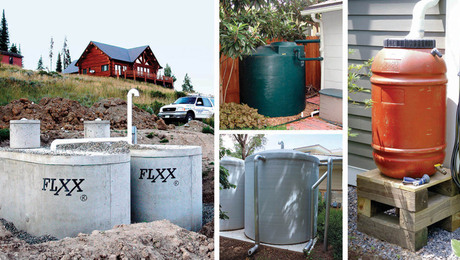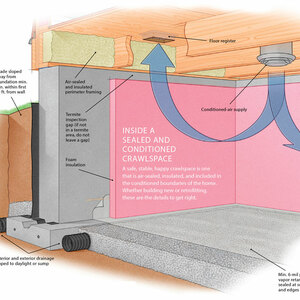How should I think about rooftop insulation versus attic?
Situation
I’m replacing my 15yr old asphalt shingle roof with a metal roof and must decide whether to insulate the roof on top or in the attic. The home is a 2004 vintage 24x40ft manufactured home on cinder block foundation with a dirt Crawlspace and a 4/12 pitch truss roof made of 2×4’s. All the ductwork and some electrical runs thru the attic and there is currently no access panel for service. There appears to be R13 or R11 batts laid across many sections of the attic – but not all. We have 3miles of open water that makes exposes us to severe winds at times. Our goals to improve comfort, do the right thing and save on energy.
Complication
We expect to add 500-1000sq ft in the near future, at which point I will need to upgrade or supplement the current furnace, AC (HVAC) and water heater (HWH). The current furnace and hot water heater are small enough to share a coat closet – with the furnace on top and tank below. Only one system of the two housed here can expand in the current space. it’d be tricky to move the furnace ducts to another location because there’s no storage or closet space.
Options
#1 I can add blown in insulation for much less than $1000 but due to the small attic space, but I’m concerned about flexibility and serviceability challenges because a foot of blown in insulation eats up half the volume of the space. When I need to grow the HVAC and HWH for the addition this might obstruct moving the furnace to the attic.
#2 I can add 4” of polyiso to the roof now for $3000 and get an R value in the low 20’s
#3 I can do a combination of the #1 and 2 or possibly spray foam portions or use other materials in the attic.
Solution
I’m looking for trade offs of one option va another and what risk I face having insulation on top of the roof as well as in the attic.
any advice is welcomed ! Including referrals to other FHB and other articles.


















Replies
How can you see what is in the attic with no access?
What is the ventilation situation in the attic, and how does the existing HVAC ductwork look?
Hi UncleMike42, sorry I didn’t get the notification that you made a post to this!
I can see into the attic thru a pair of two 2ft x 4ft voids in the drywall where I removed some commercial light fixtures.
Ventilation is thru the eaves and out a roof ridge vent. Ductwork is just the flexible stuff - like an “oversized dryer vent”
If you go with the PIC foam on the roof, how would you detail the area over the wall plates?
Good question. I’m a little outside my area of expertise, but some YouTube videos suggest enclosing the attic completely at that point.
https://youtu.be/4OrpDp5_3Rk
Depending on where you are contemplating the addition,
I would consider upgrading the existing attic ducting and attic wiring in anticipation of the addition, (and water piping, if it will extend in the attic), and go with the blown in, with proper attention to keeping the attic ventilation intact.
at a minimum, the ducts should be insulated. they can terminate in a large duct that can be fed from a new HVAC in the addition, and be closed off from the existing equipment after the transition.
You could seal off the attic and transition from a vented attic to a conditioned space.
Where you are, you want at least R30 in the roof. (more is better)
so the 4 inches of polyiso would not, by itself, do enough.
https://www.finehomebuilding.com/membership/pdf/7319/021228066.pdf
But you could put fiberglass or rock wool between the rafters and make up the difference.
Putting the polyiso on top of the roof deck and keeping the attic ventilated would not get you the full benefit that the nominal R value would suggest. The primary concern with mixed attic floor and decking insulation with the attic floor still insulated is moisture control, which has all kinds of nasty possibilities.
Great intel - thank you Uncle Mike. Compared with doing polyiso on the roof, it sounds like a single form of insulating within the attic would be the way to go - the tradeoffs there (congestion among duct pathways and potential furnace placement) are not as bad as the ones in the article that you sent.
You might want to crawl around and seal up any holes in the attic floor before you get the insulation blown in.
holes used for wiring, for plumbing, and vent lines. and around the heating ducts.
a couple cans of sealing foam can do wonders.
You could go with the foam on top, with more between the rafters, something like the option 4 on page 68.
Just want to seal up the attic venting, insulate above the wall (as suggested/hinted previously) when you seal those vents, and make sure the attic space is included in your HVAC solutions.
Would have to trust the roofing folks to know what they are doing.
Got it. I like the suggestion of setting the new furnace in the addition when the time comes and just ducting back to the old attic. This gets around some of the physical constraints that’d come with the blown in.
Also I see why the spray foam will help in any amount to make it airtight and prevent issues from the article - either with sealing the penetrations in blown in or with the whole space between the rafters if we were to make the attic conditioned space.
I appreciate your expertise in laying out the trade offs between these options!